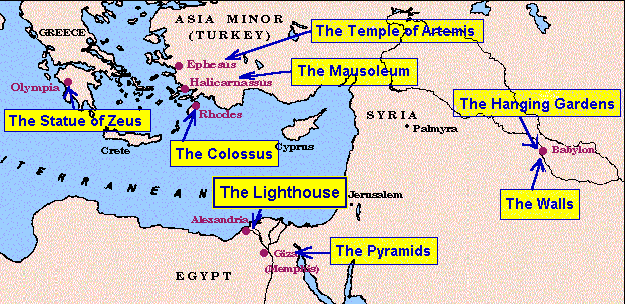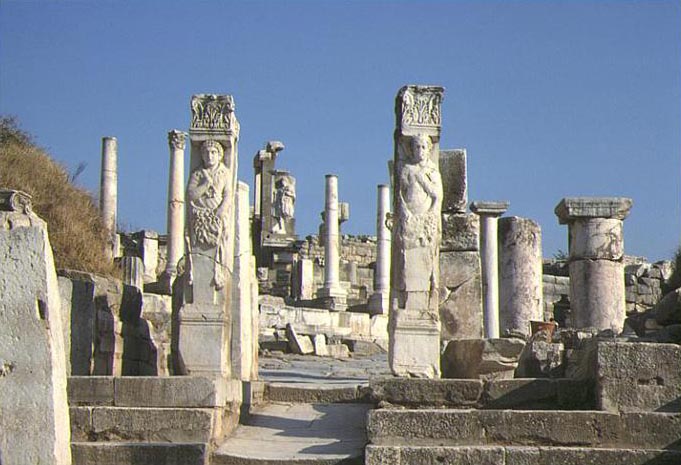�
����� (Asia Minor - Turkey)�������
EPHESUS
When one mentions such places of past history lessons like Asia Minor - then you have found Ephesus! Located in what is now the Republic of Turkey, Ephesus is about 10 km inland from the Aegean coast and approx 700 km south of Istanbul. If you look at a modern map of the Mediterranean and follow the line south east from Samos in the Greek islands to the Turkish coastline you will find the city of Kusadasi. We arrived by cruise ship into this port city and took the mini-bus or Dolmus -for a fun experience to Ephesus.
�
�
Ephesus, one of the 12 cities of Ionia (an ancient Greek district on the western coast of Asia Minor), located near modern İzmir, Turkey. As a port city at the mouth of the Cayster (modern K���kmenderes) River, it was a major departure point for trade routes into Asia Minor. Known in antiquity for its sacred shrines, notably a famous temple (one of the Seven Wonders of the World) to the goddess Artemis, or Diana, the city was also an important center of early Christianity.
________________________________________________________________
The Seven Wonders of the Ancient World

The Seven Wonders of the Ancient World are on list made by the Greeks and Romans of particularly remarkable, man-made structures. The structures were included on this list because of their great size or other unusual characteristics such as magnificent engravings or modeling.
�
__________________________________________________________________
SO� WHAT� ABOUT� EPHESUS ?
This archaeological site ranks right up there with the Colossus, Pyramids of Giza and others (see above) in being one of the wonders of the world. One walks the same path of the Romans on their way to the brothel or to take a bath. I was overwhelmed by the� many different elements of Ancient Greek and Roman culture.�A considerable amount of restoration has been done to recreate the city (and so much more needs be done). What distinguishes Ephesus from any other set of ancient ruins in the western world is the completeness of its layout.
_________________________________________________________________
ITS� HISTORY
According to the old legends, Ephesus was founded by the female warriors known as the Amazons. The name of the city is thought to have been derived from "APASAS", the name of a city in the "KINGDOM OF ARZAWA" meaning the "city of the Mother Goddess". Ephesus was inhabited from the end of the Bronze Age onwards. Carians and Lelegians are to be have been among the city's first inhabitants. Ionian migrations are said to have begun in around 1200 B.C. The region was devastated during the Cimmerian invasion at the beginning of the 7th century B.C. Under the rule of the Lydian kings, Ephesus became one of the wealthiest cities in the Mediterranean world. The defeat of the Lydian King Croesus by Cyrus, the King of Persia, prepared the way for the extension of Persian influences over the whole of the Aegean coastal region. At the beginning of the 5th century, when the Ionian cities rebelled against Persia, Ephesus quickly dissociated itself from the others, thus escaping destruction.
__________________________________________________________________
And so our journey begins...................
�
View of the entrance area on the right middle side of the photograph: the Varius Baths� which are the largest n Ephesus (upper right); the Basilica with two rows of columns was a trade center during the Roman Empire where commerce occurred (upper center); the Odeum built in the 2nd century A.D. was a place of government having 13 rows on ten rows on the upper level for 1500 people (upper center);� State Agora is the vast expanse of space in the middle of this section of Ephesus where religious and state meetings were held with the remains office buildings in the square.

Close up of the Basilica & Odeum (left) and the Varius Baths (right).� The Odeon was used for poetry-readings, small concerts and prize-giving ceremonies. Built into the slope of the hill, it could seat 2,200 people. The upper closed part of the building was entered by two side doors. The twenty-three rows of seats were divided by a diazoma into two sections, thirteen below and ten above. The lower seats seem to have been wider than those above. The highest part of the theater was decorated with Corinthian columns made of red granite.
State Agroa (foreground), Basilica and Odeum (background) with tour guide.
A short distance on the left of the pathway is the Temple of Domitian built in 81-96 A.D. and the first one built in the name of the emperors in Ephesus.
�
The Pollio Fountain with a big restored arch above it was built by the Ephesian C.S.Pollio in 97 A.D.� With the big pool in front of it, the fountain had a monumental appearance and together� with the Water Palace provided the water distribution for the city.
�
�
�
�
�
�
�
�
�
�

The gate decorated with reliefs of Heracles was built during the 4th Century A.D.
After a lengthy walk from the staging area, one finds himself at the top end of Curetes Street and this is where our journey gets more interesting. During the period of the Roman Empire, the priests dealing with both religious and state affairs were called curetes.� Since the bases� of the columns with the names of these priests inscribed on them were found at the beginning of this street, it was the Curetes Street.
�
We next pass the Trajan Fountain which was built in the 2nd century A.D.
�
�
�
�
�
�
�
�
�
�
�
Turning towards the Marble Street from the Street of the Curetes one is immediately struck by a very beautiful and decorative building on the right. This is the Temple of Hadrian built between 117 and 138 A.D.� �It measures 7.20 by 5 meters. The triangular pediment is supported by four Corinthian columns. The middle two columns support a rounded arch which has Os its keystone a bust of Cybele. According to the Roman oracles, if it were possible to bring to Rome the sacred statue of Cybele from Pessinus in AsIa Minor, Rome would conquer Carthage. The statue was taken to Rome and in this way, since Rome was victorious over Carthage, Cybele became the emblem of Rome and of Italy.
�
�
�
�
�
�
�
�
�
�
�
�
�
As you walk along the paved street you will see�ruts caused by carts and chariots as well as a footprint and female likeness directing business to the brothel.� Notice at in the distant center of the Photograph the Library of Celsus.
The famous Ephesus Library was situated to the south of the Agora. This elegant monument was built in A.D. 135 by Julius Aquila in memory of his father, Celsus Polemaeanus of Sardis, Roman Senator and Proconsul of the province of Asia.
�
�
�
�
�
�
�
�
�
To the right of the library, the Gate of Augustus, also called the Gate of Mazaeus and Mithridates, leads into the 110-metresquare commercial agora where food and craftwork items were sold. The monumental gate, dedicated to the honor of the Emperor Augustus.
�
The Great Theater with the theater gymnasium on the left and the agora on the right.� Harbour Street (Arcadiana) is the large pathway in the center.
�
�
�
�
�
�
�
�
�
�
�
�
�
�
�
�
�
�
The Great Theater, magnificently set on the western slope of Panayirdag, is undoubtedly the most interesting of all the ruins in Ephesus.�Building was begun in the reign of the Emperor Claudius (A.D. 41-54) and completed in the reign of the Emperor Trajan (98-117 A.D.). The theater could seat 24,000 people but most of the seats have been removed and used In the construction of later buildings. A wide arcaded staircase led up to a columned gallery around the top of the theater. Thirty meters above the orchestra. And finally Kathleen and myself left the Great Theater to walk down Harbour Street to our mini bus and ride back to the port city of Kusadasi.
____________________________________________________________
�
�
�
�
�
�
�
�
�
�
�
�

A visit to the famous or rather infamous (well oiled money laundering machine) then a final farewell and off to the Ship Olympus for more Greek entertainment.
And an evening of rich Greek Culture with nest stop the Island of Crete.
�
COME BACK SOON